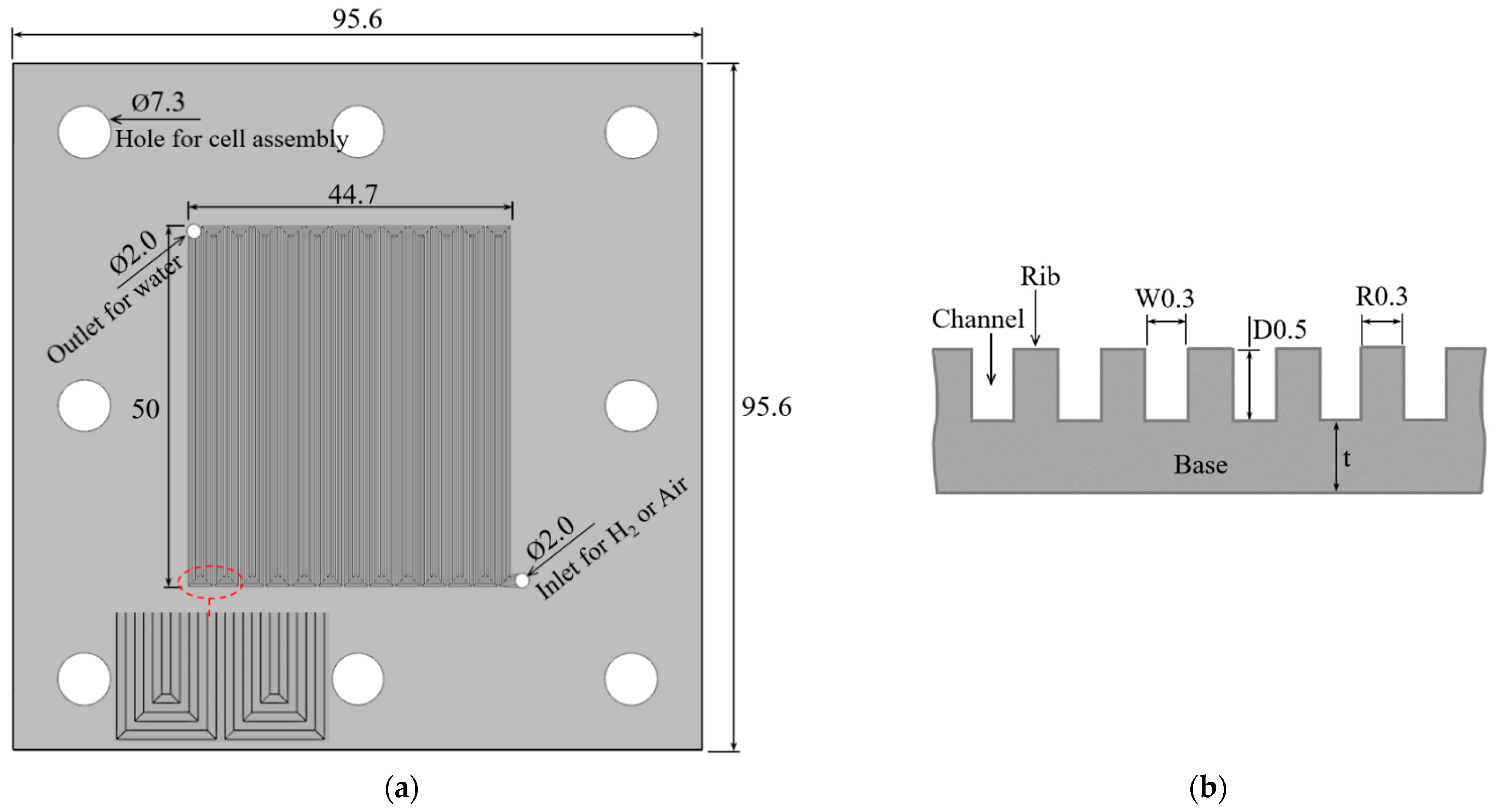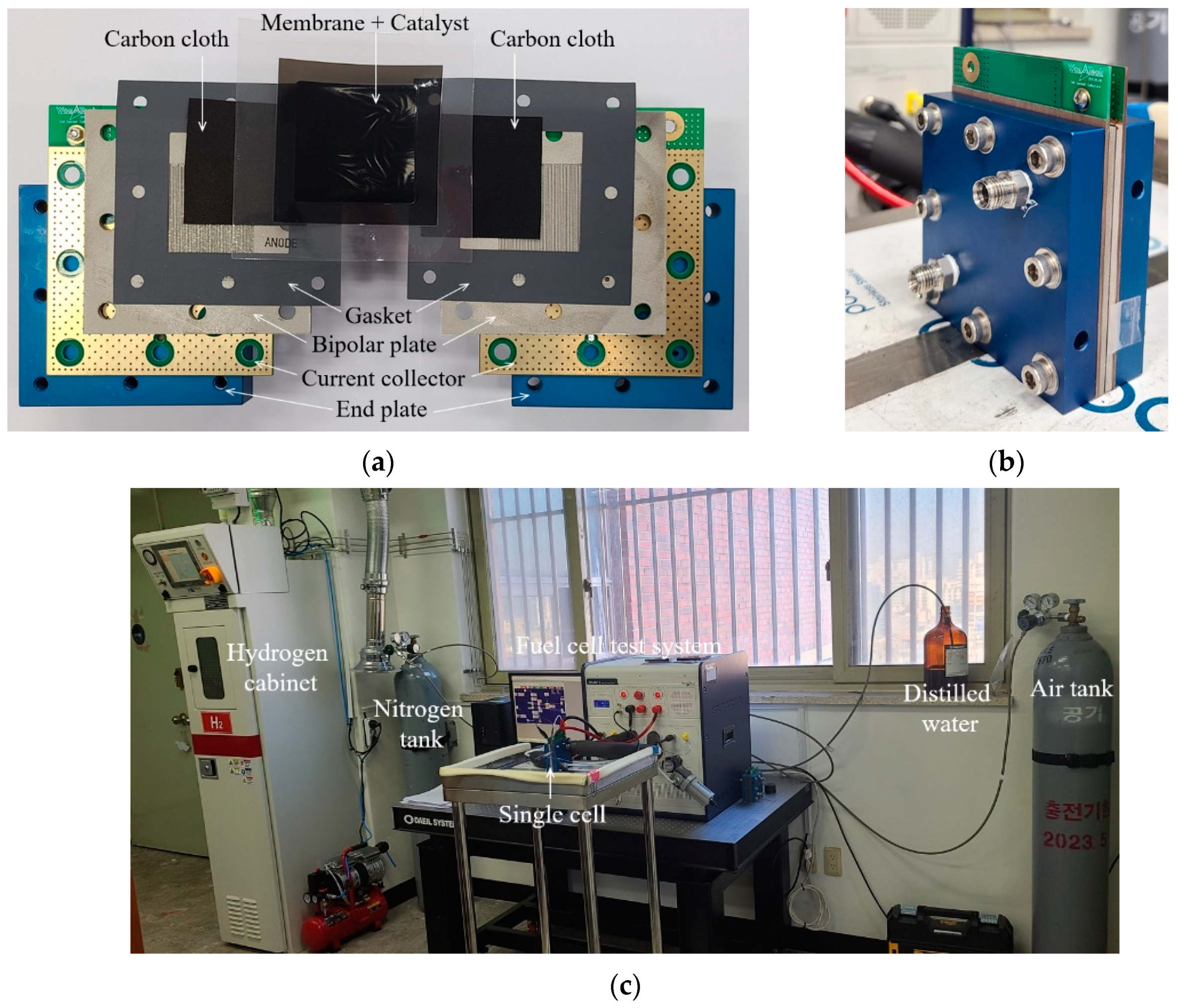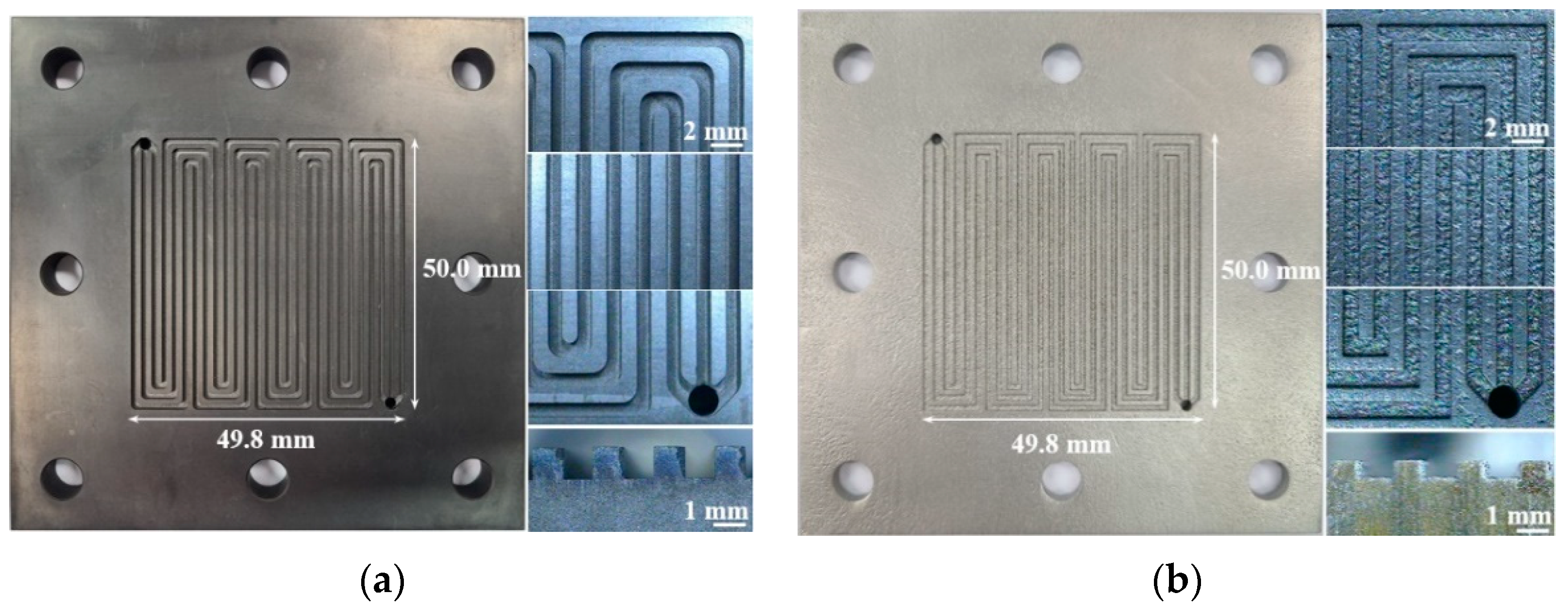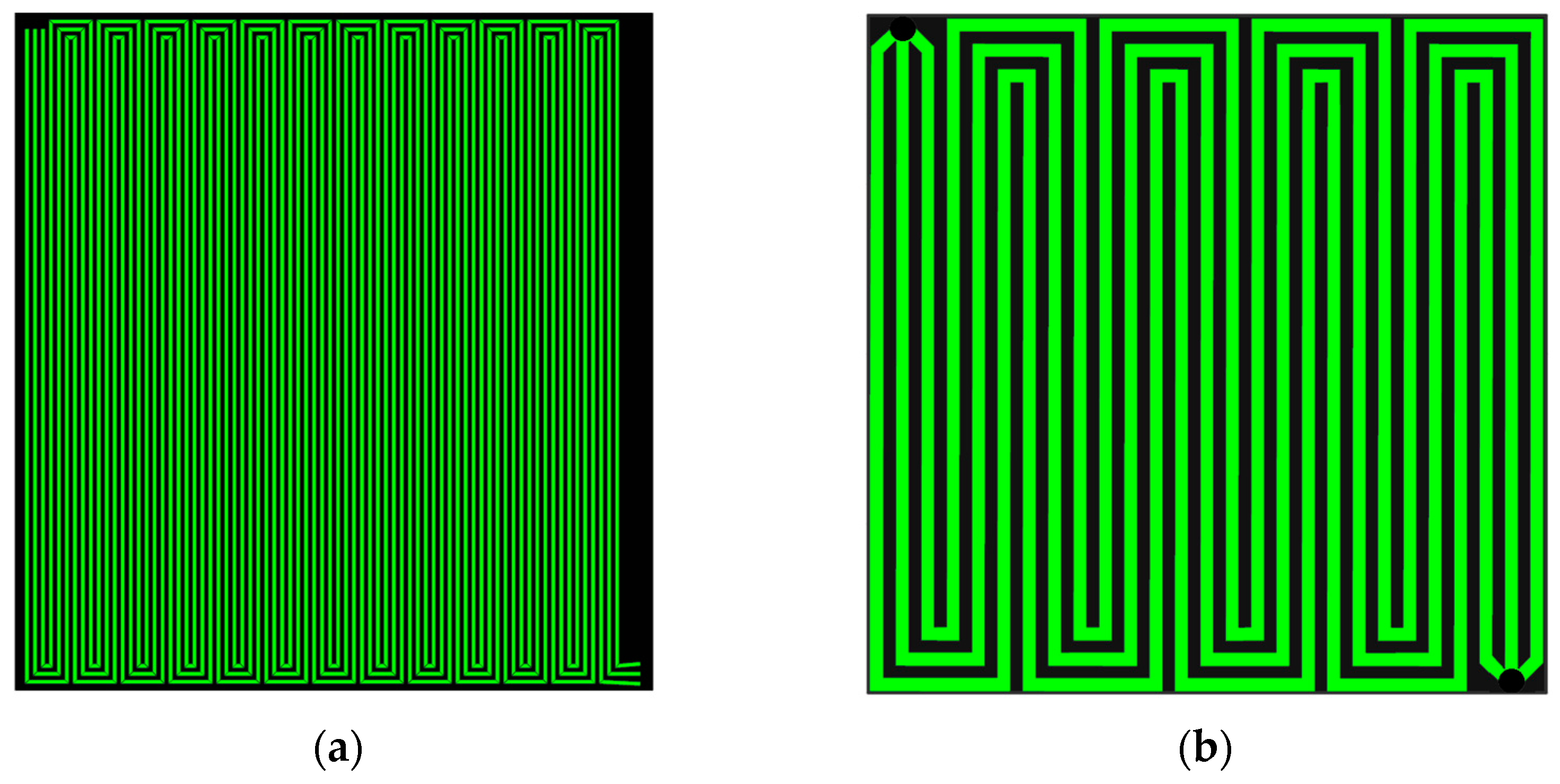Powder Bed Fusion 3D Printing and Performance of Stainless-Steel Bipolar Plate with Rectangular Microchannels and Microribs
Abstract
:1. Introduction
- -
- A PBF-3D-printer-fabricated stainless-steel bipolar plate with 300 μm rectangular channels and ribs is achieved.
- -
- Fine channels and ribs helped in increasing the current density.
- -
- The stainless-steel bipolar plate with 300 μm channels increased the current density by 52.8% more than 940 μm channels.
- -
- The stainless-steel bipolar plate with 300 μm channels increased the current density by 24.9% more than the graphite BP with 940 μm channels.
2. Three-Dimensional Design of a Bipolar Plate with 300 μm Rectangle Channels
3. Experiments
3.1. Manufacturing of Bipolar Plate with 300 μm Rectangle Channels by PBF 3D Printer
3.2. Analysis of Channel Cross-Section
3.3. Single-Cell Test
4. Experimental Results
4.1. Bipolar Plates with 300 μm Rectangle Channels Printed by PBF
4.1.1. Flatness
4.1.2. Appearance
4.1.3. Width and Depth of Channels
4.1.4. Surface Roughness
4.2. Cell Performance
4.2.1. i-V Curve (Short-Term Performance)
4.2.2. Time–Current Density Curve (Long-Term Performance)
5. Conclusions
- (1)
- The BP sample with a thickness of 1 mm had a bending phenomenon due to thermal deformation, while the sample with a thickness of 2 mm was not bent. The BP had a thickness of 1 mm. Although it had a low flatness due to bending, it was flexible enough to undergo elastic deformation to be flat by a compressive force when combined with a single cell. Therefore, all the regions in the flow field of the BP with a thickness of 1 mm adhered to the MEA excellently, so the reactant gases were not leaked out.
- (2)
- The fabricated SUS 316L BP channel shape was rectangular as in the design. The channel width was about 0.29 mm smaller by about 0.01 mm than the design size (0.3 mm), while the channel depth was 0.57 mm deeper by about 0.07 mm than the design depth (0.5 mm). The average arithmetic roughness (Ra) value was 4.316 μm, which was higher by 1.7 times than that of the CNC machined graphite BP. Porosities were almost not found from the base of the ribs, but pores were observed from various regions of the ribs, and its edges were ragged due to pores.
- (3)
- The current density of the manufactured SUS 316L BP with 0.29 mm channels (rectangle, 0.6 mm channel depth, and 0.3 mm ribs) was 1.2052 A/cm2 at 0.6 V. This value was higher by 24.9% than that of the graphite BP with 0.94 mm channels (rectangle, 1.0 mm channel depth, and 0.94 mm ribs). In addition, the current density was higher by 52.8% than that of the SUS 316L BP with 0.94 mm channels (rectangle, 0.5 mm channel depth, and 0.94 mm ribs).
- (4)
- The current density of the prepared SUS 316L BP with 0.29 mm channels reached a maximum at 1.1732 A/cm2 at 13 h in the long-term operation and reduced by 0.000561 A/cm2 per hour till 170 h. From 171 h to 260 h, the current density value was maintained at 1.0616 to 1.0296 A/cm2.
Author Contributions
Funding
Data Availability Statement
Conflicts of Interest
References
- Xing, L.; Shi, W.; Su, H.; Xu, Q.; Das, P.K.; Mao, B.; Scott, K. Membrane electrode assemblies for PEM fuel cells: A review of functional graded design and optimization. Energy 2019, 177, 445–464. [Google Scholar] [CrossRef]
- Pahon, E.; Bouquain, D.; Hissel, D.; Rouet, A.; Vacquier, C. Performance analysis of proton exchange membrane fuel cell in automotive applications. J. Power Sources 2021, 510, 230385. [Google Scholar] [CrossRef]
- Wu, S.; Yang, W.; Yan, H.; Zuo, X.; Cao, Z.; Li, H.; Shi, M.; Chen, H. A review of modified metal bipolar plates for proton exchange membrane fuel cells. Int. J. Hydrog. Energy 2021, 46, 8672–8701. [Google Scholar] [CrossRef]
- Xiong, K.; Wu, W.; Wang, S.; Zhang, L. Modeling, design, materials and fabrication of bipolar plates for proton exchange membrane fuel cell: A review. Appl. Energy 2021, 301, 117443. [Google Scholar] [CrossRef]
- Chen, K.; Laghrouche, S.; Djerdir, A. Performance analysis of PEM fuel cell in mobile application under real traffic and environmental conditions. Energy Convers. Manag. 2021, 227, 113602. [Google Scholar] [CrossRef]
- Song, Y.; Zhang, C.; Ling, C.Y.; Hand, M.; Yong, R.Y.; Sun, D.; Chen, J. Review on current research of materials, fabrication and application for bipolar plate in proton exchange membrane fuel cell. Int. J. Hydrog. Energy 2020, 45, 29832–29847. [Google Scholar] [CrossRef]
- Duan, Z.; Qu, Z.; Ren, Q.; Zhang, J. Review of Bipolar Plate in Redox Flow Batteries: Materials, Structures, and Manufacturing. Electrochem. Energy Rev. 2021, 4, 718–756. [Google Scholar] [CrossRef]
- Leng, Y.; Ming, P.; Yang, D.; Zhang, C. Stainless steel bipolar plates for proton exchange membrane fuel cells: Materials, flow channel design and forming processes. J. Power Sources 2020, 451, 227783. [Google Scholar] [CrossRef]
- Xu, Z.; Qiu, D.; Yi, P.; Peng, L.; Lai, X. Towards mass applications: A review on the challenges and developments in metallic bipolar plates for PEMFC. Prog. Nat. Sci. 2020, 30, 815–824. [Google Scholar] [CrossRef]
- Porstmann, S.; Wannemacher, T.; Drossel, W.G. A comprehensive comparison of state-of-the-art manufacturing methods for fuel cell bipolar plates including anticipated future industry trends. J. Manuf. Process. 2020, 60, 366–383. [Google Scholar] [CrossRef]
- Mahabunphachai, S.; Cora, O.N.; Koc, M. Effect of manufacturing processes on formability and surface topography of proton exchange membrane fuel cell metallic bipolar plates. J. Power Sources 2010, 195, 5269–5277. [Google Scholar] [CrossRef]
- Liu, Y.; Hua, L. Fabrication of metallic bipolar plate for proton exchange membrane fuel cells by rubber pad forming. J. Power Sources 2010, 195, 3529–3535. [Google Scholar] [CrossRef]
- Hung, J.C.; Lin, C.C. Fabrication of micro-flow channels for metallic bipolar plates by a high-pressure hydroforming apparatus. J. Power Sources 2012, 206, 179–184. [Google Scholar] [CrossRef]
- Hung, J.C.; Yang, T.C.; Li, K.C. Studies on the fabrication of metallic bipolar plates-Using micro electrical discharge machining milling. J. Power Sources 2011, 196, 2070–2074. [Google Scholar] [CrossRef]
- Abeyrathna, B.; Zhang, P.; Pereira, M.P.; Wilkosz, D.; Weiss, M. Micro-roll forming of stainless steel bipolar plates for fuel cells. Int. J. Hydrog. Energy 2019, 44, 3861–3875. [Google Scholar] [CrossRef]
- Jin, C.K.; Kang, C.G. Fabrication process analysis and experimental verification for aluminum bipolar plates in fuel cells by vacuum die-casting. J. Power Sources 2011, 196, 8241–8249. [Google Scholar] [CrossRef]
- Jin, C.K.; Jung, M.G.; Kang, C.G. Fabrication of Aluminum Bipolar Plates by Semi-solid Forging Process and Performance Test of TiN Coated Aluminum Bipolar Plates. Fuel Cells 2014, 21, 551–560. [Google Scholar] [CrossRef]
- Development of Bi-Polar Plates for Fuel Cells JAPAN. Available online: https://www.syvec.co.jp/en/rd/plates/ (accessed on 19 October 2022).
- Li, X.; Sabir, I. Review of bipolar plates in PEM fuel cells: Flow-field designs. Int. J. Hydrog. Energy 2005, 30, 359–371. [Google Scholar] [CrossRef]
- Peng, L.; Yi, P.; Lai, X. Design and manufacturing of stainless steel bipolar plates for proton exchange membrane fuel cells. Int. J. Hydrog. Energy 2014, 39, 21127–21153. [Google Scholar] [CrossRef]
- Wang, Y.; Zhou, B.; Liu, Z.; Tu, Z.; Liu, W. Numerical study and performance analyses of the mini-channel with discrete double-inclined ribs. Int. J. Heat Mass Transf. 2014, 78, 498–505. [Google Scholar] [CrossRef]
- Askari, M.; Hutchins, D.A.; Thomas, P.J.; Astolfi, L.; Watson, R.L.; Abdi, M.; Ricci, M.; Laureti, S.; Nie, L.; Freear, S.; et al. Additive manufacturing of metamaterials: A review. Addit. Manuf. 2020, 36, 101562. [Google Scholar] [CrossRef]
- Slotwinski, J.A.; Garboczi, E.J.; Stutzman, P.E.; Ferraris, C.F.; Watson, S.S.; Peltz, M.A. Characterization of Metal Powders Used for Additive Manufacturing. J. Res. Natl. Inst. 2014, 119, 460–493. [Google Scholar] [CrossRef] [PubMed]
- Housholder, R.F. Molding Process. U.S. Patent 4247508, 27 January 1981. [Google Scholar]
- Savolainen, J.; Collan, M. How Additive Manufacturing Technology Changes Business Models—Review of Literature. Addit. Manuf. 2020, 32, 01070. [Google Scholar] [CrossRef]
- Yusuf, S.M.; Cutler, S.; Gao, N. Review: The Impact of Metal Additive Manufacturing on the Aerospace Industry. Metals 2019, 9, 1286. [Google Scholar] [CrossRef] [Green Version]
- Zhang, L.; Zhang, S.; Zhu, H.; Hu, Z.; Wang, G.; Zeng, X. Horizontal dimensional accuracy prediction of selective laser melting. Mater. Des. 2018, 160, 9–20. [Google Scholar] [CrossRef]
- Izonin, I.; Tkachenko, R.; Gregus, M.; Duriagina, Z.; Shakhovska, N. PNN-SVM Approach of Ti-Based Powder’s Properties Evaluation for Biomedical Implants Production. Comput. Mater. Contin. 2022, 71, 5933–5947. [Google Scholar] [CrossRef]
- Izonin, I.; Tkachenko, R.; Duriagina, Z.; Shakhovska, N.; Kovtun, V.; Lotoshynska, N. SmartWeb Service of Ti-Based Alloy’s Quality Evaluation for Medical Implants Manufacturing. Appl. Sci. 2022, 12, 5238. [Google Scholar] [CrossRef]
- Gould, B.D.; Rodgers, J.A.; Schuette, M.; Bethune, K.; Louis, S.; Rocheleau, R.; Lyons, K.S. Performance and Limitations of 3D-Printed Bipolar Plates in Fuel Cells. ECS J. Solid State Sci. Technol. 2015, 4, 3063–3068. [Google Scholar] [CrossRef]
- Trogadas, P.; Cho, J.I.S.; Neville, T.P.; Marquis, J.; Wu, B.; Brett, D.J.L.; Coppens, M.O. A lung-inspired approach to scalable and robust fuel cell design. Energy Environ. Sci. 2018, 11, 136–143. [Google Scholar] [CrossRef] [Green Version]
- Zhang, C.; Wang, S.; Li, J.; Zhu, Y.; Peng, T.; Yang, H. Additive manufacturing of products with functional fluid channels: A review. Addit. Manuf. 2020, 36, 101490. [Google Scholar] [CrossRef]
- Wang, X.L.; Qu, Z.G.; Lai, T.; Ren, G.F.; Wang, W.K. Enhancing water transport performance of gas diffusion layers through coupling manipulation of pore structure and hydrophobicity. J. Power Sources 2022, 525, 231121. [Google Scholar] [CrossRef]













| Laser Power | Scan Speed | Jump Speed | Minimum Feature Size |
|---|---|---|---|
| 215 W | 900 mm/s | 15,000 mm/s | 100 μm |
| Cr | Ni | Mo | Mn | Si | N | P | S | C | Fe |
|---|---|---|---|---|---|---|---|---|---|
| 16.5–18.5 | 10.0–13.0 | 2.0–2.5 | 2.0 | 1.0 | 0.11 | 0.045 | 0.03 | 0.03 | Bal. |
| Thermal Conductivity (at 20 °C) | Thermal Expansion Coefficient | Melting Range | Density |
|---|---|---|---|
| 15 W/mK | 19 × 10−6 m/m °C | 1370–1400 °C | 8.0 g/cm3 |
| Membrane | Catalyst | Anode Catalyst Loading | Cathode Catalyst Loading | Gas Diffusion Layer | Active Area |
|---|---|---|---|---|---|
| Nafion 212 | 50 wt.% Pt on Vulcan (carbon) | 0.12 mg/cm2 | 0.45 mg/cm2 | Carbon cloth with MPL and PTFE | 25 cm2 |
| Fuel | Anode, Cathode Flow Rate | H2, Air Stoichiometry | Gas Humidified Temperature | Cell Temperature | Operating Pressure |
|---|---|---|---|---|---|
| H2, Air | 300 ccm, 750 ccm | 1.5, 3.0 | 75 °C | 75 °C | 1 atm |
| BP Type | Graphite by CNC Machine | SUS 316L by Metal 3D Printer |
|---|---|---|
| Shape of the channel | Rectangle | Rectangle |
| Width of the channel | 0.94 mm | 0.94 mm |
| Depth of the channel | 1.0 mm | 0.5 mm |
| Width of the rib | 0.94 mm | 0.94 mm |
| Cross-section area of a channel | 0.94 mm2 | 0.47 mm2 |
| Number of channels | 27 ea | 27 ea |
| Area of the flow field | 2490 mm2 | 2490 mm2 |
| Area of channels | 1338.2 mm2 | 1338.2 mm2 |
| Volume of channels | 1338.2 mm3 | 669.1 mm3 |
Publisher’s Note: MDPI stays neutral with regard to jurisdictional claims in published maps and institutional affiliations. |
© 2022 by the authors. Licensee MDPI, Basel, Switzerland. This article is an open access article distributed under the terms and conditions of the Creative Commons Attribution (CC BY) license (https://creativecommons.org/licenses/by/4.0/).
Share and Cite
Jin, C.K.; Kim, J.H.; Lee, B.-S. Powder Bed Fusion 3D Printing and Performance of Stainless-Steel Bipolar Plate with Rectangular Microchannels and Microribs. Energies 2022, 15, 8463. https://doi.org/10.3390/en15228463
Jin CK, Kim JH, Lee B-S. Powder Bed Fusion 3D Printing and Performance of Stainless-Steel Bipolar Plate with Rectangular Microchannels and Microribs. Energies. 2022; 15(22):8463. https://doi.org/10.3390/en15228463
Chicago/Turabian StyleJin, Chul Kyu, Jae Hyun Kim, and Bong-Seop Lee. 2022. "Powder Bed Fusion 3D Printing and Performance of Stainless-Steel Bipolar Plate with Rectangular Microchannels and Microribs" Energies 15, no. 22: 8463. https://doi.org/10.3390/en15228463
APA StyleJin, C. K., Kim, J. H., & Lee, B.-S. (2022). Powder Bed Fusion 3D Printing and Performance of Stainless-Steel Bipolar Plate with Rectangular Microchannels and Microribs. Energies, 15(22), 8463. https://doi.org/10.3390/en15228463







